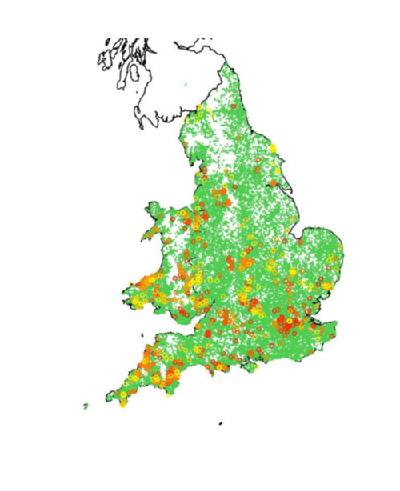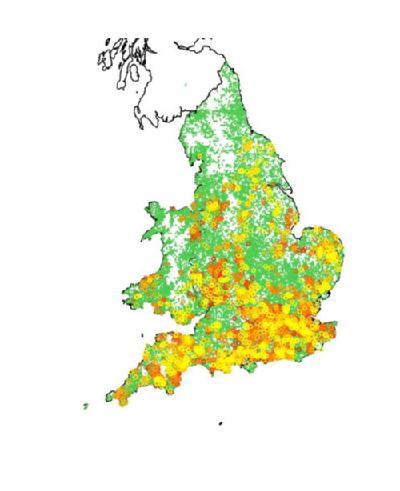Impact: Bee Diseases
Endemic pathogens: European foulbrood (Melissococcus plutonius) and American foulbrood (Paenibacillus larvae)
The pressure upon honeybees for their polliation services to agriculture has been increasing in the last twenty years, as hyuman populations have risen and food security has become a more pertinent issue than ever. The level of disease in bee populations has also increased, including parasites (e.g. the Varroa mite and small hive beetle), bacteria (such as European and American foulbrood) and viruses (including deformed wing virus and the Kashmir bee virus). Until Warwick became officially involved with the Insect Pollinator Initiative (IPI) in 2011, epidemiological methods had not been applied to study the transmission of these diseases; since then we have worked closely with the Food and Environment Research Agency (FERA) to assist in predicting (and hence controlling) the spread of many honeybee diseases, present in the UK and/or worldwide.
Samik Datta was the postdoctoral research fellow employed on the IPI project entitled "Modelling systems for managing bee disease: the epidemiology of European foulbrood", supervised by Matt Keeling
was the postdoctoral research fellow employed on the IPI project entitled "Modelling systems for managing bee disease: the epidemiology of European foulbrood", supervised by Matt Keeling and Jim Bull
and Jim Bull . The work involved using 20 years of data collected in the UK by the National Bee Unit (NBU)
. The work involved using 20 years of data collected in the UK by the National Bee Unit (NBU) , which manages bee health on behalf of DEFRA and the Welsh government in England and Wales. The data comprises of visits made to apiaries by regional bee inspectors, and the presence / absence of European foulbrood (EFB) and American foulbrood (AFB), two endemic diseases in the UK. As a practice run for dealing with the whole UK dataset we first utlilsed information on a small epidemic of AFB on the island of Jersey (off the south coast of England) in 2010, and the results of this analysis have already been published. Using the UK data we then parameterised models to predict the spread of both diseases in the UK, and are currently writing a manuscript to describe our findings. We are hoping for the results of the modelling work to influence future NBU policy to limit the spread of these diseases. The established modelling framework also allowed us to move on to tackle novel invasive pests and pathogens.
, which manages bee health on behalf of DEFRA and the Welsh government in England and Wales. The data comprises of visits made to apiaries by regional bee inspectors, and the presence / absence of European foulbrood (EFB) and American foulbrood (AFB), two endemic diseases in the UK. As a practice run for dealing with the whole UK dataset we first utlilsed information on a small epidemic of AFB on the island of Jersey (off the south coast of England) in 2010, and the results of this analysis have already been published. Using the UK data we then parameterised models to predict the spread of both diseases in the UK, and are currently writing a manuscript to describe our findings. We are hoping for the results of the modelling work to influence future NBU policy to limit the spread of these diseases. The established modelling framework also allowed us to move on to tackle novel invasive pests and pathogens.
AFB
|
EFB
|
Figure 1: Detection of AFB and EFB in the UK between 1994 and 2012 by NBU inspectors. Green points indicate apiaries negative for the respective disease at all inspections; positive points are given by non-green circles (changing from red for older positive inspections to yellow for more recent ones).
Recent invasive pests: Varroa (Varroa destructor)
The varroa mite is the most widespread honeybee pest or pathogen, being present in almost all apiaries worldwide (except for Australia, which is the only country considered to be varroa-free). Varroa is a parasitic mite which attaches itself to a honeybee host and weakens it, leading to further diseases such as deformed wing virus, and can result in death of a colony if left untreated.
Varroa was first detected in the UK by NBU inspectors in 1992 (in the region of Exeter), and over the next six years spread rapidly through England and Wales, before finally being declated an endemic pest in 1997.
Publications
- Samik Datta, James C. Bull, Giles E. Budge, Matt J. Keeling (2013), 'Modelling the spread of American foulbrood in honeybees', Journal of the Royal Society Interface 10(88), no. 20130650 [ARTICLE
 ]
]


